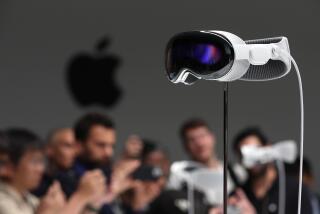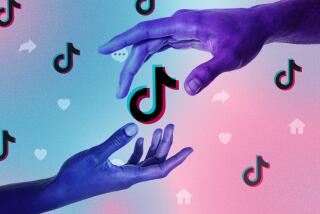Looking for a reason to love the iPad
- Share via
I have tried — really tried — to fall in love with the iPad.
I’ve spent hours trying it out. Reading, browsing, gaming. Watching movies. I’ve trawled Apple’s website for killer apps. Conferred with the blue-shirted geniuses at my local Apple store about the wonders of the tablet-enabled lifestyle.
I’ve checked out the favorite apps of my iPad-equipped friends, and tried to conjure every way I might use the iPad for health, happiness and profit.
But it’s not happening.
There’s no point pretending that there aren’t millions of people who do, in fact, love the iPad. They can’t all be self-deluding, so we can stipulate that for many, many people it’s a marvelous device. Apple says it sold about 25 million units in the first nine months of this year. Throw in sales of wannabe iPads such as Amazon’s Kindle Fire and Samsung’s Galaxy Tab, and it sometimes seems as though pretty soon every atom in the universe will own its own tablet computer.
But if you’re one of the millions who woke up this Christmas morning feeling guilty that you didn’t spring for an iPad for your family, or got one and can’t figure out what all the excitement’s about, or think the whole tablet computing craze is another case of consumers being goaded by slick advertising into buying something they don’t need, don’t be ashamed. If you can’t tell what the pad is good for, you don’t need it. I’m on your side.
Let’s be clear that I’m not taking an anti-Apple position. On the contrary, I’m devoted to my Apple MacBook Air, which is the best computer I’ve ever owned. And I’ve sampled and spurned non-Apple tablets such as the Galaxy Tab and Kindle Fire.
I don’t “hate the iPad,” like the sizable cadre of bloggers given to proclaiming their distaste online. I’m merely indifferent to its supposed virtues, as I am to many other cultural phenomena I’m expected to find fascinating, like Ryan Seacrest and Pippa Middleton.
My biggest issues with the iPad fall into three categories: its poor screen resolution, its lack of a decent input mechanism and Apple’s totalitarian approach to its App Store. We’ll take them in order.
The iPad screen may be adequate for video or animated games, but it’s nowhere near sharp enough for comfortable extended viewing of anything involving the printed word: books, magazines, websites. That’s especially true at the less-than-arm’s-length viewing distance for which the iPad is designed. My black-and-white Kindle e-reader may be worthless for Web browsing, but the sharpness of its print display leaves the iPad in the dust and its passive non-backlit screen is much easier on the eyes.
The absence of a keyboard as a creative and communication tool is the tablet device’s most striking feature, and, for me, its disabling drawback. Tablet fans contend that its touch screen interface is a great advance in interactive technology. Sorry, I’m not buying. The on-screen virtual keyboard is no substitute for the tactile feedback of a real keyboard; it seems purposely designed to discourage writing anything but the most rudimentary grunts. If you need a device the creative empowerment of which begins and ends with the typing of tweets, here you are. I happen to require something more. But that’s me.
Although iPad users can surf the Web using its built-in Safari browser, plainly its stand-alone apps are the focus of the user experience. Apple brags that some 500,000 apps by third-party software developers, including about 140,000 specifically written for the iPad, are available from its App Store. But none can be marketed without the say-so of Apple, which keeps 30% of the purchase price.
This is a disquieting approach. For one thing, it relentlessly drives up the ownership cost of the iPad. For example, I’m about to embark on a project for which a lot of the source material will be digital documents known as pdf files: articles from technical journals, newsletters, book chapters, etc. I was excited to think that the iPad might be convenient for reading and annotating these files, and assumed that it came with a free program for doing so, akin to the excellent Preview program embedded in my MacBook’s operating system. No such luck: I’d have to buy a separate app, for $9.99. That may not seem like a lot of money, but if you’re already spending more than $500 for a high-tech device, why should you have to keep paying to personalize it, at 10 bucks a pop?
Apple superintends the App Store like a blue-nosed corporate Mrs. Grundy, regularly ejecting apps that displease it. This process sometimes seems virtuous, as when the offending app is violent or anti-Semitic or could be used to promote child pornography.
But what about when Apple’s decisions seem motivated by political pressure, as when Apple removed an app that pointed users toward WikiLeaks? Or by narrow commercial considerations, as when it mandated changes in e-book apps from Amazon and other vendors so that it would get a fee whenever a user bought a book directly via the app? What are the limits of Apple’s corporate intrusiveness into my decision about how to use my iPad? No one can be sure, because Apple reserves the right to make and change the rules at will.
Take away the ability to interact with the iPad creatively and the freedom to use it as you wish, and you’re left with what iPad aficionados tout as the finest device ever made for consuming entertainment content. This is a cramped vision of an object’s utility, a bit like calling a luxury BMW the best device ever for consuming premium gasoline. But it is revealing, for it clarifies that the real beneficiary of the iPad revolution is Apple, for which the device is a siphon into its owner’s wallet via the sale of videos, movies, music, apps, magazine subscriptions, etc., etc., etc., etc.
Maybe I’m just missing the indispensability of tablets. I am reminded of the question that the late cultural anthropologist Neil Postman used to ask of every new technology: “What is the problem to which this is the solution?” At this moment, I don’t seem to have any problems to which the tablet is the solution. If my lifestyle were one for which people have told me the iPad is a boon — if I commuted to work every day by train or bus or boarded cross-country flights more than a few times a year, say — perhaps my answer would be different.
It’s also conceivable that technological improvements will resolve some of my misgivings. Rumors already are swirling that the iPad 3, which could be out early next year, will boast a super-sharp “Retina” display. Yet Apple rumors always require a grain of salt. The current forecasts are that the new iPad will be either thinner or thicker than the iPad 2; have the Retina display or the same old display; cost more than the current version or be the same price. (No one predicts it will be cheaper.)
If you’ve survived this long without jumping into the iPad pond, you certainly haven’t wasted any money. The one safe prediction that can be made is that before long people will look back at today’s crop of tablets, shake their heads in dismay and say, “You mean to tell me you paid 500 bucks for that?”
Michael Hiltzik’s column appears Sundays and Wednesdays. His latest book is “The New Deal: A Modern History.” Reach him at mhiltzik@latimes.com, read past columns at latimes.com/hiltzik, check out facebook.com/hiltzik and follow @latimeshiltzik on Twitter.
More to Read
The biggest entertainment stories
Get our big stories about Hollywood, film, television, music, arts, culture and more right in your inbox as soon as they publish.
You may occasionally receive promotional content from the Los Angeles Times.











